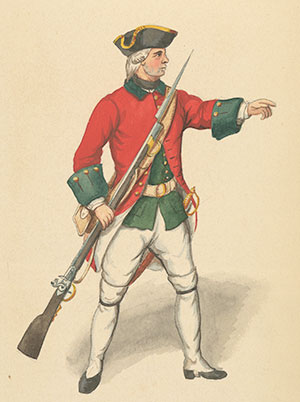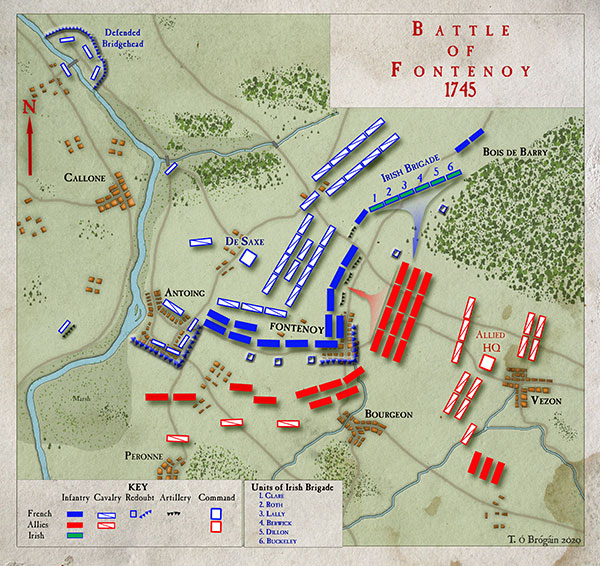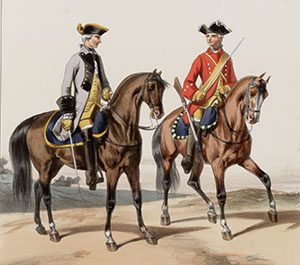‘Cuimnidh ar Luimneach!’—the Irish Brigade at the Battle of Fontenoy
Published in Features, Issue 3 (May/June 2020), Volume 28On 11 May 1745—275 years ago—Thomas Lally de Tollendal roused the Irish Brigade with ‘Cuimnidh ar Luimneach agus ar feall na Sasanach!’ (‘Remember Limerick and Saxon perfidy!’) prior to their epic charge at Fontenoy.
By Stephen McGarry

Above: A soldier of Lally’s Regiment of France, 1761. (Vinkhuizen Collection, New York Public Library)
The Battle of Fontenoy was a defining battle of the War of the Austrian Succession, fought in modern-day Belgium. To secure success in Flanders, France laid siege to Tournai, where the renowned military theorist Marshal of France Maurice de Saxe assembled his army. The duke of Cumberland, William Augustus, George II’s favourite son, commanded a 50,000-man Allied coalition made up of first-class English, Dutch and Hanoverian troops hastily sent to Tournai’s relief.
The skilful Saxe manoeuvred his 45,000 troops to the plateau at Fontenoy, the gateway to Tournai, and eagerly awaited the Allies’ arrival. Saxe wanted to channel Cumberland’s army onto the exposed open ground between the Bois de Barry and Fontenoy, and positioned a number of gun-batteries, the most important being at the redoubt d’Eu, to suck them into a trap.
Make-up of the Irish Brigade
The Irish Brigade, under the command of Charles O’Brien, the 6th Lord Clare, were at full strength, comprising the infantry regiments of Dillon’s, Clare’s, Berwick’s, Buckeley’s, Lally’s and Roth’s (3,870 bayonets) and including four squadrons of Fitzames’s Horse (270 sabres). The Irish infantry were held in reserve on the left flank, beside the Bois de Barry, while Fitzjames’s Horse took post in the centre of the field.
As dawn broke on 11 May 1745, French batteries opened up. Cumberland responded by sending in his cavalry to attack Fontenoy while his Dutch allies assailed nearby Antoing, but both assaults were pushed back by heavy cannon fire. An infantry assault on the redoubt d’Eu at the Bois de Barry also failed. It was around noon when Cumberland was forced to march his Anglo-Hanoverian infantry, as Saxe had hoped, a half-mile through the open ground between the Bois de Barry and Fontenoy while being pounded by heavy enfilade fire from gun-batteries at Fontenoy and the redoubt d’Eu, which cut swathes through the Allied ranks.
The ‘infernal column’
Against Saxe’s expectations, the 15,000-strong Allied infantry column, with a dozen six-pounder cannon dragged to its front, continued its dogged, uphill march through the murderous cannon fire. Even though the column had lost a third of its strength, drummers continued to beat the charge as the sergeants’ halberds held their men in line and frantically closed gaps. They marched as if on parade, their battle formation a testament to coolness in battle and good military training.
At around 12.30pm the Allied infantry halted again, to dress their ranks (i.e. bring troops into line), 300 paces from the French first line. To Saxe’s horror, the ‘infernal column’ pressed onwards, and at 70 paces unleashed a deadly rolling volley, which broke through Saxe’s first line, composed of premier infantry regiments of the Gardes Françaises and Gardes Suisse, some of which even broke and ran.
The column had now nearly reached the centre of the French position and no longer felt the enfilade fire that it had just passed by. Nobody could stop them. Cumberland knew that he was on the cusp of victory, and to hammer home his victory he ordered his cavalry to advance from the rear.
Saxe thought the battle was lost. The French king, Louis XV, was even urged to leave the field, and could be observed nervously biting the fleur de lis embroidered in the corner of his handkerchief. The French commander needed to throw everything he had at the ‘infernal column’; he brought forward four cannon and blasted it with grapeshot at close range. Dillon’s regiment, together with the régiments de Normandie and Vasseaux, were ordered to advance, but they were soon repelled with heavy losses.

Irish advance
Saxe now ordered up the remaining Irish infantry who were still held in reserve, but they needed time to form up. He launched a number of squadrons, including Fitzjames’s Horse, to stop the column, but the French cavalry failed to press their charges home. Saxe, however, had gained the time that he needed. At around 1.30pm, the five fresh Irish regiments, including the remaining troops of Dillon’s, Normandie and Vasseaux, who had taken part in an earlier attack, had formed into line. The Irish wheeled about, shouting ‘Huzzah!’ as they advanced. ‘Cuimnidh ar Luimneach agus ar feall na Sasanach!’ yelled Colonel Lally, as he drew his sword. This battle-cry—made in reference to the broken Treaty of Limerick and to their forced exile—was repeated down the ranks.
The French high command held its breath as the Irish advanced with fixed bayonets on the column’s right flank, their bagpipers belting out the Jacobite anthem ‘The White Cockade’. At the same time, French infantry attacked the left flank, while cavalry charged the column’s front. The high drama escalated as the Irish marched up the hill when an unnamed officer from the Coldstream Guards suddenly rushed out to the front of the Allied column and challenged Captain Anthony McDonough to single combat with swords. The two armies momentarily froze to witness the fight. The Irishman parried and smashed his adversary’s sword arm, forcing him to the ground, while a thousand ‘huzzahs’ came from the back.
The Irish received a volley which brought down their first line, but they emerged through the billowing musket smoke, without firing, and smashed violently through the English foot with bayonets. Lord Clare narrowly escaped death as two musket-balls hit his metal breastplate but bounced back off. Sergeant Wheelock of Buckeley’s captured a British flag. Within minutes, the bruised and battered column finally halted, broke into fragments and fell back. Cumberland retreated all night to nearby Ath, where he burst into tears at his defeat. The Wild Geese’s charge had saved the day for France and had snatched victory from the jaws of defeat.
Promotions and pensions
King Louis rode down to the Irish troops first and told them he owed victory to them; he promoted Sergeant Wheelock to sous-lieutenant for capturing a flag, the only one taken in the battle. The wounded Colonel Thomas Lally and Lt. Colonel Stapleton of Berwick’s were raised to brigadier generals. Other officers were promoted, received pensions and gratuities and were decorated with the coveted Cross of St Louis. The Irish were further rewarded with captured British supplies. Louis XV even replaced the 75 horses lost by Fitzjames at his own expense, even though it was usual for the regiment to pay for its losses itself. The Irish spent the night in the middle of the battlefield amongst the dying and wounded, their bagpipers playing ‘Saint Patrick’s Day in the Morning’ to perk the men up amidst cheers from the Brigade.

Above: A trooper (right) of Fitzjames’s Horse, 1758. (Het Legermuseum, Nationale Bibliotheek Van Nederland)
The Battle of Fontenoy—one of the most murderous battles of the eighteenth century—was the highpoint of the Bourbon dynasty and secured Louis XV’s reputation as a great warrior king. Fontenoy was also the Wild Geese’s highest battle honour and the pinnacle of Irish military prowess. It was the greatest win over an English army (albeit under French colours) since the 1598 Battle of the Yellow Ford in County Armagh. Allied losses totalled 7,545 men and the French lost a similar number, but the Irish suffered higher losses in proportion to any other French unit. One quarter of their officers were either killed or wounded, including Colonel Dillon, killed at the head of his regiment—a total of 656 men. Irishmen fought on both sides at Fontenoy. A number of Irish Catholics served with the British, despite the Catholic ban on recruitment, including in three squadrons of the mainly Protestant Irish 6th (Inniskilling) Dragoons.
News of Irish valour spread throughout Europe. The famous French writer Voltaire, who had arrived to witness the battle, downplayed the Irish charge, unwilling to admit that a foreign corps had secured victory for France. He printed 21,000 copies of his Poème de Fontenoy, which conflicted with the official account, crediting the régiment de Normandie’s charge for victory. However, Saxe and his subordinate commanders, and subsequent historians, acknowledge the decisive part played by the Irish charge in breaking the Allied square.
Captured British colours
The legend that the Coldstream Guards lost colours to the Irish came from the official French account of the battle, but the duke of Cumberland reported that no colours were lost. Silken flags measuring 6ft square were carried by junior officers and were escorted by two battle-hardened colour sergeants. For a regiment to lose its colours was a major disgrace, as captured flags were held as trophies of war and were draped high in the vaults of churches and cathedrals. A French writer provided, to my knowledge, the only description of the flag taken at Fontenoy. While researching an illustrated manuscript in Paris of flags taken by the French during the Flanders campaign, I came across a flag marked as having being taken in 1745, surmounted with the motto ‘Nisi Dominus frustra’ (‘Except the Lord it is in vain’), identifying it, most probably, as the flag captured by Sergeant Wheelock of Buckeley’s. This flag likely came from Sempill’s Regiment of Foot (later to become the King’s Own Scottish Borderers). Sempill’s fought in the battle on the right flank of the column alongside the Coldstream Guards, which was attacked by the Irish Brigade.
The Guards Museum in London confirmed that this flag, or any of the other half-dozen flags presented to them, did not belong to any Guards regiment and they had no record of colours being lost at Fontenoy. The regimental museum of the King’s Own Scottish Borderers (formerly Sempill’s Regiment) was intrigued but suggested that the flag may have been an early regimental or company colour.
What happened to the Fontenoy flag? In 1814, when the Russians were closing in on Paris, Minister for War Henri Clarke, born in France to Irish parents, ordered all captured colours held in the chapel of the old soldiers’ home of Les Invalides to be burned to prevent their being taken by the Russians. Veterans scaled ladders in the chapel and removed the flags. In all, 1,417 flags—including a flag taken by the Irish Brigade at Fontenoy—were flung into the flames of the courtyard of Les Invalides that night and disappeared forever.
Stephen McGarry is the author of Irish Brigades abroad (The History Press Ireland, 2013).
FURTHER READING
M. McNally, Fontenoy 1745: Cumberland’s bloody defeat (Oxford, 2017).
J. O’Callaghan, History of the Irish Brigades in the service of France (Glasgow, 1870).
J. White, Marshal of France: the life and times of Maurice de Saxe (London, 1962).
















